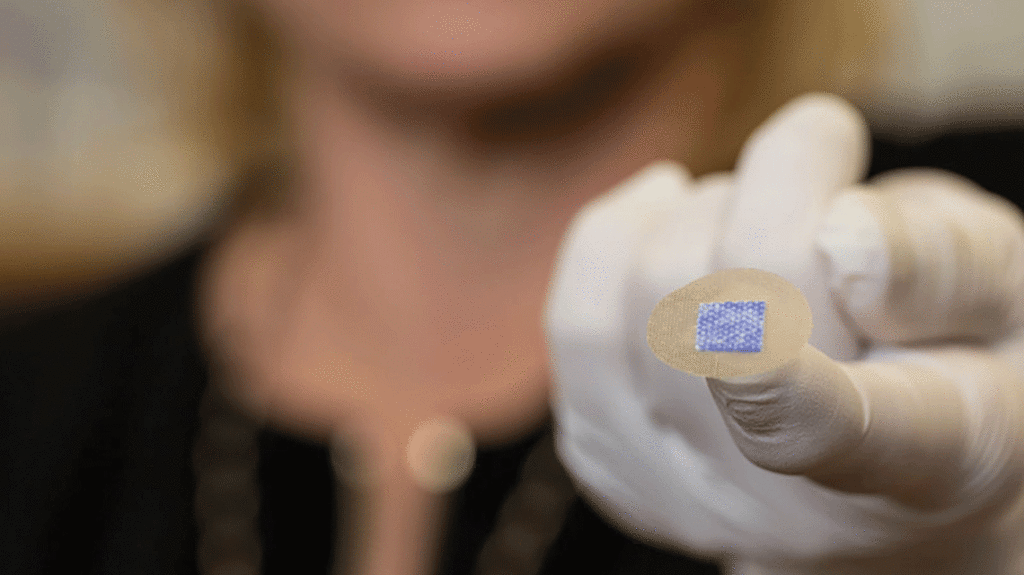Needle-free Immunization Prevents Experimental Otitis Media
Needle-free Immunization Prevents Experimental Otitis Media https://pediatricsnationwide.org/wp-content/uploads/2017/06/VaccinePatch.gif 1024 575 Tiasha Letostak, PhD Tiasha Letostak, PhD https://pediatricsnationwide.org/wp-content/uploads/2021/03/Tiasha-Letostak.jpg- June 20, 2017
- Tiasha Letostak, PhD

The first data to demonstrate the efficacy of a simple, needle-free vaccine delivery system for middle ear infections.
Otitis media (OM), or middle ear infection, accounts for approximately 30 million doctor visits a year in the U.S. The pathogen nontypeable Haemophilus influenzae (NTHI) causes the majority of cases of ear infection, including chronic OM, recurrent OM, and OM associated with treatment failure. In the first study of its kind, a team of investigators from Nationwide Children’s Hospital and Tulane University School of Medicine has developed a way to deliver a vaccine against ear infections through the skin, which would prevent the bacteria from causing the disease.
“Almost every child will develop an ear infection and unfortunately, some children will have seven or eight before their first birthday,” says Laura Novotny, MS, research program manager in the Bakaletz Lab at the Center for Microbial Pathogenesis in The Research Institute at Nationwide Children’s Hospital, and primary author of the recent study, which was published in Clinical and Vaccine Immunology. “These chronic infections can result in language, developmental and educational delays, which are all factors with long-term consequences.”
According to Lauren Bakaletz, PhD, director of the Center for Microbial Pathogenesis and senior author on the study, the best way to stop this cycle is to prevent the disease from even happening.
“A vaccine against ear infections could result in a reduction in antibiotic use, alleviate the child’s ear pain and require less time off of work for the caretaker,” says Dr. Bakaletz, who is also a principal investigator in the Center for Microbial Pathogenesis. “Transcutaneous immunization is a way to deliver the vaccine through the skin that does not require a needle jab and instead uses a small, circular bandage that is placed onto the skin behind the ear.”
The research team hopes that the simplicity of this approach could promote acceptance and allow for greater distribution of vaccines to children in parts of the world who do not have easy access to health care.
As part of the study, several vaccine candidates were tested, including two that targeted surface proteins of NTHI and a third that targeted a protein that is critical for the bacteria to build a biofilm within the nose and ear.
“The procedure for immunization required that vaccine formulations were placed on the gauze pad of a circular bandage and then the bandage was affixed to the skin behind the ear,” explains Novotny. “Keeping the practicality of a bandage remaining on a child in mind, we removed the bandage after 24 hours.”
Another important aspect of this work is that the team mimicked the disease course in children. Often, when a child is diagnosed with an ear infection, their parent reports that the child had a cold a week earlier. Researchers copied this time course by giving the animal models a viral “cold,” and then inoculated them with bacteria one week later. They then looked in their ears every day for 28-30 days, simulating what a doctor does when a child is taken to a clinic, to see if there was fluid behind the ear drums. The presence of fluid indicated an ear infection; no fluid indicated that the vaccine had prevented an ear infection.
In terms of the significance of the study results, Dr. Bakaletz says, “Immunization with a bandage helped the immune system mount a local immune response that targeted the bacterial and biofilm proteins. This response ultimately prevented the bacteria from causing disease. This is also the first time that needle-free immunization has been tested in a model that mimics the actual ear infection disease course observed in children.”
The team continues to learn more about the potential of transcutaneous immunization with their NTHI and biofilm-targeted proteins and hopes to begin testing the needle-free vaccines in the near future.
“Immunization using a bandage is a simple and highly effective strategy,” says Novotny. “Combined with our vaccine candidates, this approach has tremendous potential to reduce the burden of otitis media worldwide.”
Reference:
Novotny LA, Clements JD, Goodman SD, Bakaletz LO. Transcutaneous immunization with a bandaid prevents experimental otitis media in a polymicrobial model. Clinical and Vaccine Immunology. 2017 Apr 5 [Epub ahead of print].
About the author
Tiasha is the senior strategist for Clinical & Research Communications at Nationwide Children's Hospital. She provides assistance to investigators in The Research Institute and clinician-scientists at Nationwide Children’s for internal and external communication of clinical studies, peer-reviewed journal articles, grant awards and research news. She is also the editor-in-chief for Research Now, Nationwide Children's monthly, all-employee e-newsletter for research, as well as a writer for Pediatrics Nationwide.
-
Tiasha Letostak, PhDhttps://pediatricsnationwide.org/author/tiasha-letostak-phd/
-
Tiasha Letostak, PhDhttps://pediatricsnationwide.org/author/tiasha-letostak-phd/
-
Tiasha Letostak, PhDhttps://pediatricsnationwide.org/author/tiasha-letostak-phd/July 14, 2014
-
Tiasha Letostak, PhDhttps://pediatricsnationwide.org/author/tiasha-letostak-phd/September 3, 2014
- Posted In:
- In Brief







